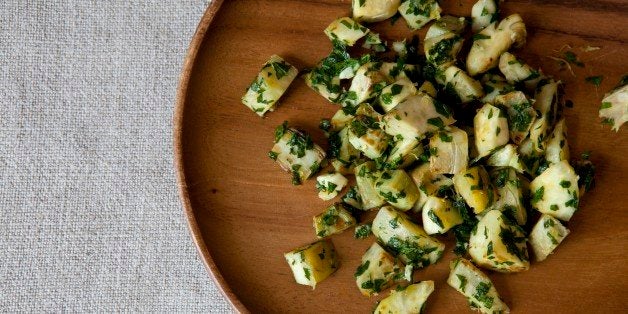
Today on Food52, Christopher Boswell, chef at the Rome Sustainable Food Project and author of Verdure: Vegetable Recipes from the Kitchen of the American Academy in Rome, schools us on five Italian ways to add flavor to any vegetable dish.
Vegetables are at the heart of each meal served by the Rome Sustainable Food Project at the American Academy in Rome. In fact, 7 of the 11 meals served each week are entirely vegetable-based, and verdure are truly the backbone of the RSFP. The highest praise we get from our dining community and their guests is for how we prepare our vegetables -- in a way that makes them both interesting and appealing every time.
People often ask me, “How can I make my vegetable dishes more exciting at home?” My new book, Verdure, provides a repertoire of Italian- and California-inspired recipes for great seasonal vegetable dishes that are uncomplicated and approachable, yet still refined.
Here are a few simple tricks that will add complexity and depth of flavor to any dish, and turn even the most boring vegetable preparation (think boiled cauliflower) into something thrilling, time and time again.
1. Homemade breadcrumbs and croutons add fantastic texture to any dish and are a great way to use up slightly stale bread. They also couldn’t be easier to make: Simply cut off the crust and buzz the day-old bread in a food processor until you get pebble-sized pieces for breadcrumbs, or cut the crustless bread into cubes for croutons.
Toss the bread crumbs with generous amounts of extra-virgin olive oil and salt, then bake them on a cookie sheet in the oven at 325° F, stirring often, until they're perfectly golden brown. Enjoy breadcrumbs over roasted vegetables, hearty salads, herb-stuffed tomatoes, or fresh shell beans; add croutons to homemade Caesar salads or soups. Both keep well in an airtight container for up to one week.
2. Store-bought can’t compare to homemade mayonnaise or aioli. Their silky texture and rich flavor make these sauces well worth the mixing effort, and they don’t take very long to come together.
The key here is to keep whisking constantly as you add the trickle of oil to the eggs until you obtain a thick, smooth, creamy and opaque mixture. I like to use a 2:1 ratio of vegetable oil to olive oil for a more neutral flavor. Drizzle over fresh shell beans and tomatoes; mix with a little mustard to dress boiled leeks, fennel, and beets; or add pounded anchovies, herbs, and Parmesan for a pungent Caesar salad dressing.
3. Frying herbs is a great way to add crispiness to your vegetable dishes. Rosemary and sage are the best herbs to fry up: Just heat some frying oil to 350° F and lower in the herbs for about 30 seconds, or until the sizzling reduces. Drain them quickly.
Try fried rosemary needles tossed with roasted cauliflower and breadcrumbs, crumble fried sage over braised fennel, or toss a medley of fried herbs into a delicious salsa verde to spoon over sweet roasted vegetables.
4. I love salsa verde because of its versatility. It is traditionally served with roasted or boiled meats, but it is equally delicious when paired with roasted, braised, or boiled vegetables. Salsa verde can be prepared in a myriad of ways; it is essentially a combination of chopped herbs, onions macerated in some form of acid (lemon juice or vinegar), salt-packed capers, and extra-virgin olive oil.
My go-to combination is parsley, mint, and a little thyme, macerated minced red onions, and lemon juice and zest. When summer rolls around, I love to make my salsa verde with red wine vinegar instead of lemon and add basil, chervil, or tarragon to the mix. Rinsed salt-packed capers are infinitely more tasty than brined capers, and are worth the investment.
Try adding in a chopped up hard boiled egg for a salsa rustica, which is delicious with boiled asparagus; crumble in some fried rosemary and sage to add liveliness to roasted or blanched vegetables; or mix it with chopped up toasted salted almonds -- it's especially great over roasted beets.
5. Avoid store-bought stuff like garlic- and basil-flavored olive oil that has been sitting on a store shelf for who knows how long, and make your own flavored and infused oils or yogurts in a matter of seconds; the difference is huge.
Adding herbs to an olive oil- or yogurt-based dressing can really raise the flavor bar. I like to buzz some fennel fronds or basil leaves with extra-virgin olive oil for an herb oil that will add complexity to any dish. Mint, basil, parsley, and tarragon -- or virtually any other herb -- mixed into yogurt can turn an otherwise flat dish into something fresh and irresistible. Try drizzled mint yogurt over roasted eggplant, or fennel frond olive oil over fresh oranges with roasted beets and walnuts.
Cauliflower and beet salad photos by Annie Schlechter; all other photos by James Ransom
This article originally appeared on Food52.com: 5 Ways to Add Flavor to Any Vegetable Dish
Food52 is a community for people who love food and cooking. Follow them at Food52.com -- and check out their new kitchen and home shop, Provisions.